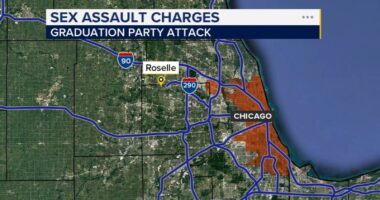Share this @internewscast.com

WASHINGTON (AP) — In California, a majority of voters found themselves at odds with the idea of changing congressional district boundaries to favor Democrats. However, many felt cornered, viewing this as a necessary move due to limited options left by Republicans.
The AP’s extensive Voter Poll, which surveyed over 4,000 Californians, revealed a conflicted electorate. While many didn’t necessarily agree with redistricting outside of Census years, they supported it as a countermeasure against President Donald Trump’s strategies aimed at maintaining Republican control in the upcoming midterm elections. This sentiment reflects a reluctant embrace of redistricting as a strategic necessity rather than a preferred approach.
The passage of the ballot measure, despite voters’ reservations, underscores a perception of redistricting as a political imperative. For many, it represents a critical juncture, reflecting a willingness to make uncomfortable compromises given the perceived stakes for the nation’s political landscape.
California voters said party control of Congress was highly important
While about 90% of California voters expressed a preference for non-partisan commissions to handle congressional districting, a majority still voted in favor of Proposition 50. This measure aims to redraw districts in a way that would likely increase Democratic representation in the House.
Approximately 70% of Californians indicated that the party in control of Congress was “very important” to them. Among these voters, there was strong support for the state constitutional amendment championed by Democratic Governor Gavin Newsom, who has been a vocal critic of Trump.
Before the vote, Newsom emphasized the gravity of the situation, suggesting that the future of democracy itself was on the line.
“Prop 50 is not about drawing lines on a map,” Newsom told a crowd. “It is about holding the line to what makes us who we are.”
The ballot measure was a response to Trump’s efforts earlier this year to tilt more congressional districts toward the GOP. Voter discontent with the status quo was apparent. About half of California voters said they are angry about the country’s direction, and a similar share pointed to the economy as the most important issue facing the state. Many voters have been left frustrated as Trump’s pledge to vanquish inflation has gone unfulfilled, while his import taxes have created a sense of confusion and chaos among businesses and the public.
The president has successfully pushed Texas, North Carolina, Ohio and Missouri to craft new congressional districts, with Trump placing pressure on additional states in an attempt to swing midterm races that have traditionally favored the party out of the White House.
“The Unconstitutional Redistricting Vote in California is a GIANT SCAM in that the entire process, in particular the Voting itself, is RIGGED,” Trump wrote.
Proposition 50’s “Yes” voters hoped to counter Republicans in other states
Two-thirds of California voters said they were opposed to states redrawing their congressional district lines in response to how other states have drawn their lines. But the vast majority of the voters who supported the ballot measure said it was necessary to counter the changes made by Republicans in other states.
California now has the chance to do that by recrafting its 52 House seats in ways that could add five Democrats to Congress in next year’s elections. Democrats and voters who lean toward the Democrats — who make up a majority of voters in the state — overwhelmingly voted in support of the ballot measure.
Many acknowledged the process so far has been unjust. About half of California voters said neither the Republicans nor the Democrats are handling the redrawing of congressional district lines fairly.
But knowing the choices made by other state legislatures, enough California voters decided they had the right reason – even if it felt like the wrong thing.
—-
The 2025 AP Voter Poll, conducted by SSRS from Oct. 22 – Nov. 4, includes representative samples of registered voters in California (4,490), New Jersey (4,244), New York City (4,304) and Virginia (4,215). The AP Voter Poll combines data collected from validated registered voters online and by telephone, with data collected in-person from election day voters at approximately 30 precincts per state or city, excluding California. Respondents can complete the poll in English or Spanish. The overall margin of sampling error for voters, accounting for design effect, is plus or minus 2.0 percentage points in California, 2.1 percentage points in New Jersey, 2.2 percentage points in New York City, and 2.1 percentage points in Virginia.















